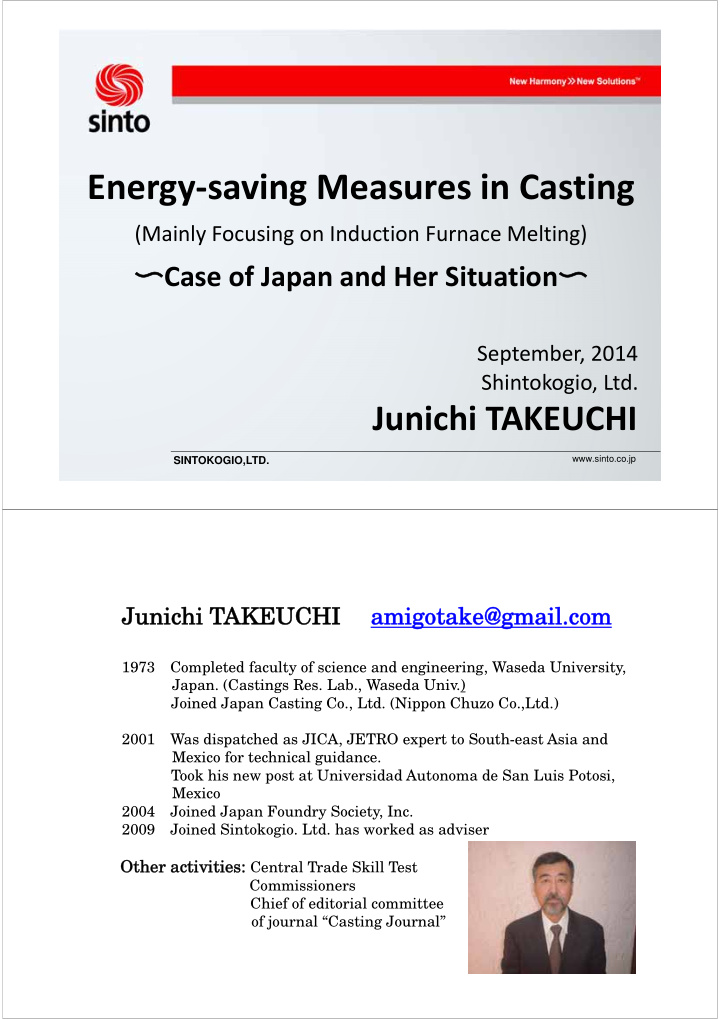



Energy ‐ saving Measures in Casting (Mainly Focusing on Induction Furnace Melting) ~ Case of Japan and Her Situation ~ September, 2014 Shintokogio, Ltd. Junichi TAKEUCHI www.sinto.co.jp SINTOKOGIO,LTD. Junichi T Junichi TAKEUCHI AKEUCHI amigotake@gmail.com amigotake@gmail.com 1973 Completed faculty of science and engineering, Waseda University, Japan. (Castings Res. Lab., Waseda Univ.) Joined Japan Casting Co., Ltd. (Nippon Chuzo Co.,Ltd.) 2001 Was dispatched as JICA, JETRO expert to South-east Asia and Mexico for technical guidance. Took his new post at Universidad Autonoma de San Luis Potosi, Mexico 2004 Joined Japan Foundry Society, Inc. 2009 Joined Sintokogio. Ltd. has worked as adviser Other Other activities: ctivities: Central Trade Skill Test Commissioners Chief of editorial committee of journal “Casting Journal”
Casting Production Top ‐ 10 Countries Iron Based Casting Production TOP ‐ 5 Countries Rapidly increasing of productions in India and China 4 0 . 0 ] n C h i n a o 3 5 . 0 T n o i l l i 3 0 . 0 M U S A [ n o 2 5 . 0 i t c u d 2 0 . 0 o J a p a n r P g n 1 5 . 0 i t s a G e r m a n y C 1 0 . 0 s u o r r 5 . 0 e F I n d i a 0 . 0 8 9 0 1 2 3 4 5 6 7 8 9 0 1 9 9 0 0 0 0 0 0 0 0 0 0 1 1 9 9 0 0 0 0 0 0 0 0 0 0 0 0 1 1 2 2 2 2 2 2 2 2 2 2 2 2 Source: Modern Casting
Current Situation and Problems Regarding Energy Saving in Each Field Pig Iron Casting Energy Consumption of Pig Iron Casting (conversion of calorific value) MJ/t Average of 3 pig-iron-related Average of 9 production lines in 7 organizations and 72 foundries foundries Energy consumption Percentage (%) Energy consumption Percentage (%) Purchase power 4,558 55.6 5,831 61.0 Coke 2,118 25.8 2,544 26.4 City gas 145 1.8 462 4.8 Liquefied petroleum gas 261 3.2 647 6.7 Liquefied natural gas 2 Volatile oil (Gasoline) 19 0.2 Kerosene 246 3.0 Light oil 65 0.8 Heavy oil A 778 9.5 102 1.1 Total 8,192 100.0 9,642 100.0
Energy Consumption by Casting Process (conversion of calorific value) MJ/t Energy consumption Percentage Percentage (%) by process (MJ/t) (% including "Other") Material receiving / melting 6,130 72.1 66.2 Sand treatment 880 10.3 9.5 Core molding 359 4.2 3.9 Molding 611 7.2 6.6 Molten treatment / Pouring 157 1.8 1.7 Shake-out mold / cooling 18 0.2 0.2 Fettling 347 4.1 3.7 Sub-total 8,510 100.0 91.8 Others 763 8.2 Total 9,270 100 Usage of Melting Furnace 1997 (Unit) 3 tons or more but Less than 3 tons 3 tons or more Total less than 10 tons Cupola 39 175 26.0 592 (34%) Induction electric furnace 733 340 25.0 1,098 (63%) Arc furnace 44 4 5.0 53 (3%) Total 1,168 (67%) 519 (30%) 56 (3%) 1,743 (100%)
Non ‐ ferrous Casting (1) Energy ‐ saving by improving yields (2) Improving energy efficiency by energy management technology ① Induction furnace ② Combustion furnace (3) Energy ‐ saving for process and facility ① Molding process ② Environmental problem Casting Machine and Equipment (1) Cupola melting (2) Electric furnace melting (3) Molding machine (Mass production=Green sand, self ‐ hardening property) (4) Other casting equipment
History of Green Sand Molding Machine Period 1950 1960 1970 1980 1990 2000 Sand Slinger Jolt Squeeze Jolt squeeze Air-flow squeeze Shock Aeration + preset squeeze Speeding ‐ up Improving accuracy of casting Mechanize / pressurized Key Word Automation Labor saving / FMS Downsizing Power Source and Energy Consumption Hydraulic Hydraulic Electric Pneumatic Electric (Proportional solenoid control) Inverter / Turbo (Valve switching control) Energyconsumption Large Small
Direction and Technical Development problems (issues) of Energy Saving in Casting ① Technology which makes the most of resources and facilitates recycling reuse ② Technology which minimizes emissions in production process ③ Technology for minimizing use energy and using effectively at the maximum ④ Technology which contributes to establishment of an information society, and construction of high ‐ quality society with safety and security Recommendations of Problems • Gathering of foundries • Rapid melting and pouring system for one flask • Measures for improving thermal efficiency (Example) Installation / improvement of furnace cap (cover), control of water ‐ cooled temperature, decrease of melting temperature, thickness of lining, remaining heat of materials, others. • Melting power setting and review of furnace • Reduction of power consumption of compressor • Heat retention and heat insulation of a heat radiation part
3Rs in terms of Resource Saving Present Situation of Actual Status of Energy Use
CO 2 Emission in Casting Industry Energy Consumption in Foundry
Energy Required for Casting Actual Condition of Melting Energy Investigated
For Reducing Energy Consumption (1) Reducing amount of returned (2) Reducing product weight itself (3) Reducing pouring weight itself (4) Melting consumption Melting consumption = Theoretical melting energy + Operation loss + Equipment loss P = e o + Lo + Lm Basics of Reducing Energy Consumption
Flow of Energy in Melting Process Views on Energy Saving • Energy (Electric, Coal/Coke, Gas, Kerosene, Heavy oil, etc.) • Viewpoint based on a variety of different condition, situation and circumstances • How to deal with; oil crisis (shock), resource saving, relation with greenhouse gas, CO 2 emission • Energy consumption
Comparison of Energy Consumption with CO 2 Emission Ratio of Energy Consumption Ratio of CO 2 Emission (crude oil equivalent) Energy Saving and Capital Investment • Large capital (capacity) investment • Way of operation, strengthening of management • "Clear goal setting" is carried out by "Participation by all“.
Thank you for your kind attention! Junichi TAKEUCHI
Recommend
More recommend